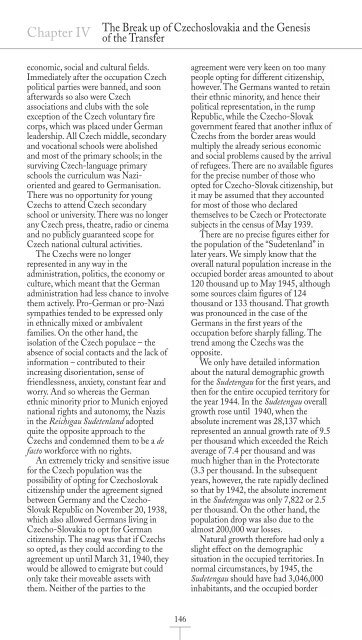the nationality of all inhabitants of the czech provinces and ...
the nationality of all inhabitants of the czech provinces and ...
the nationality of all inhabitants of the czech provinces and ...
Create successful ePaper yourself
Turn your PDF publications into a flip-book with our unique Google optimized e-Paper software.
Chapter IV<br />
economic, social <strong>and</strong> cultural fields.<br />
Immediately after <strong>the</strong> occupation Czech<br />
political parties were banned, <strong>and</strong> soon<br />
afterwards so also were Czech<br />
associations <strong>and</strong> clubs with <strong>the</strong> sole<br />
exception <strong>of</strong> <strong>the</strong> Czech voluntary fire<br />
corps, which was placed under German<br />
leadership. All Czech middle, secondary<br />
<strong>and</strong> vocational schools were abolished<br />
<strong>and</strong> most <strong>of</strong> <strong>the</strong> primary schools; in <strong>the</strong><br />
surviving Czech-language primary<br />
schools <strong>the</strong> curriculum was Nazioriented<br />
<strong>and</strong> geared to Germanisation.<br />
There was no opportunity for young<br />
Czechs to attend Czech secondary<br />
school or university. There was no longer<br />
any Czech press, <strong>the</strong>atre, radio or cinema<br />
<strong>and</strong> no publicly guaranteed scope for<br />
Czech national cultural activities.<br />
The Czechs were no longer<br />
represented in any way in <strong>the</strong><br />
administration, politics, <strong>the</strong> economy or<br />
culture, which meant that <strong>the</strong> German<br />
administration had less chance to involve<br />
<strong>the</strong>m actively. Pro-German or pro-Nazi<br />
sympathies tended to be expressed only<br />
in ethnic<strong>all</strong>y mixed or ambivalent<br />
families. On <strong>the</strong> o<strong>the</strong>r h<strong>and</strong>, <strong>the</strong><br />
isolation <strong>of</strong> <strong>the</strong> Czech populace – <strong>the</strong><br />
absence <strong>of</strong> social contacts <strong>and</strong> <strong>the</strong> lack <strong>of</strong><br />
information – contributed to <strong>the</strong>ir<br />
increasing disorientation, sense <strong>of</strong><br />
friendlessness, anxiety, constant fear <strong>and</strong><br />
worry. And so whereas <strong>the</strong> German<br />
ethnic minority prior to Munich enjoyed<br />
national rights <strong>and</strong> autonomy, <strong>the</strong> Nazis<br />
in <strong>the</strong> Reichsgau Sudetenl<strong>and</strong> adopted<br />
quite <strong>the</strong> opposite approach to <strong>the</strong><br />
Czechs <strong>and</strong> condemned <strong>the</strong>m to be a de<br />
facto workforce with no rights.<br />
An extremely tricky <strong>and</strong> sensitive issue<br />
for <strong>the</strong> Czech population was <strong>the</strong><br />
possibility <strong>of</strong> opting for Czechoslovak<br />
citizenship under <strong>the</strong> agreement signed<br />
between Germany <strong>and</strong> <strong>the</strong> Czecho-<br />
Slovak Republic on November 20, 1938,<br />
which also <strong>all</strong>owed Germans living in<br />
Czecho-Slovakia to opt for German<br />
citizenship. The snag was that if Czechs<br />
so opted, as <strong>the</strong>y could according to <strong>the</strong><br />
agreement up until March 31, 1940, <strong>the</strong>y<br />
would be <strong>all</strong>owed to emigrate but could<br />
only take <strong>the</strong>ir moveable assets with<br />
<strong>the</strong>m. Nei<strong>the</strong>r <strong>of</strong> <strong>the</strong> parties to <strong>the</strong><br />
The Break up <strong>of</strong> Czechoslovakia <strong>and</strong> <strong>the</strong> Genesis<br />
<strong>of</strong> <strong>the</strong> Transfer<br />
146<br />
agreement were very keen on too many<br />
people opting for different citizenship,<br />
however. The Germans wanted to retain<br />
<strong>the</strong>ir ethnic minority, <strong>and</strong> hence <strong>the</strong>ir<br />
political representation, in <strong>the</strong> rump<br />
Republic, while <strong>the</strong> Czecho-Slovak<br />
government feared that ano<strong>the</strong>r influx <strong>of</strong><br />
Czechs from <strong>the</strong> border areas would<br />
multiply <strong>the</strong> already serious economic<br />
<strong>and</strong> social problems caused by <strong>the</strong> arrival<br />
<strong>of</strong> refugees. There are no available figures<br />
for <strong>the</strong> precise number <strong>of</strong> those who<br />
opted for Czecho-Slovak citizenship, but<br />
it may be assumed that <strong>the</strong>y accounted<br />
for most <strong>of</strong> those who declared<br />
<strong>the</strong>mselves to be Czech or Protectorate<br />
subjects in <strong>the</strong> census <strong>of</strong> May 1939.<br />
There are no precise figures ei<strong>the</strong>r for<br />
<strong>the</strong> population <strong>of</strong> <strong>the</strong> “Sudetenl<strong>and</strong>” in<br />
later years. We simply know that <strong>the</strong><br />
over<strong>all</strong> natural population increase in <strong>the</strong><br />
occupied border areas amounted to about<br />
120 thous<strong>and</strong> up to May 1945, although<br />
some sources claim figures <strong>of</strong> 124<br />
thous<strong>and</strong> or 133 thous<strong>and</strong>. That growth<br />
was pronounced in <strong>the</strong> case <strong>of</strong> <strong>the</strong><br />
Germans in <strong>the</strong> first years <strong>of</strong> <strong>the</strong><br />
occupation before sharply f<strong>all</strong>ing. The<br />
trend among <strong>the</strong> Czechs was <strong>the</strong><br />
opposite.<br />
We only have detailed information<br />
about <strong>the</strong> natural demographic growth<br />
for <strong>the</strong> Sudetengau for <strong>the</strong> first years, <strong>and</strong><br />
<strong>the</strong>n for <strong>the</strong> entire occupied territory for<br />
<strong>the</strong> year 1944. In <strong>the</strong> Sudetengau over<strong>all</strong><br />
growth rose until 1940, when <strong>the</strong><br />
absolute increment was 28,137 which<br />
represented an annual growth rate <strong>of</strong> 9.5<br />
per thous<strong>and</strong> which exceeded <strong>the</strong> Reich<br />
average <strong>of</strong> 7.4 per thous<strong>and</strong> <strong>and</strong> was<br />
much higher than in <strong>the</strong> Protectorate<br />
(3.3 per thous<strong>and</strong>. In <strong>the</strong> subsequent<br />
years, however, <strong>the</strong> rate rapidly declined<br />
so that by 1942, <strong>the</strong> absolute increment<br />
in <strong>the</strong> Sudetengau was only 7,822 or 2.5<br />
per thous<strong>and</strong>. On <strong>the</strong> o<strong>the</strong>r h<strong>and</strong>, <strong>the</strong><br />
population drop was also due to <strong>the</strong><br />
almost 200,000 war losses.<br />
Natural growth <strong>the</strong>refore had only a<br />
slight effect on <strong>the</strong> demographic<br />
situation in <strong>the</strong> occupied territories. In<br />
normal circumstances, by 1945, <strong>the</strong><br />
Sudetengau should have had 3,046,000<br />
<strong>inhabitants</strong>, <strong>and</strong> <strong>the</strong> occupied border


